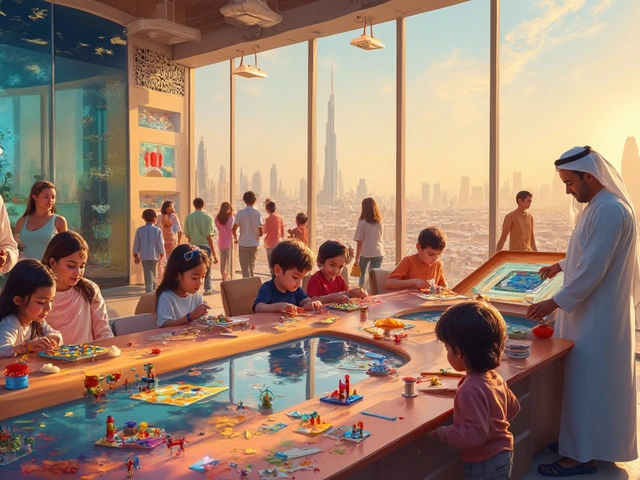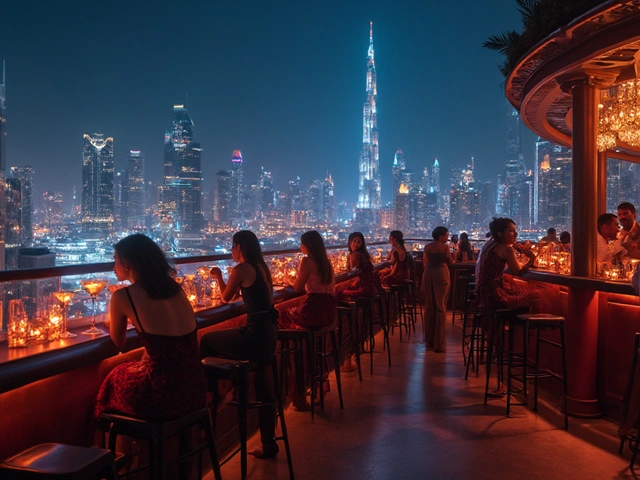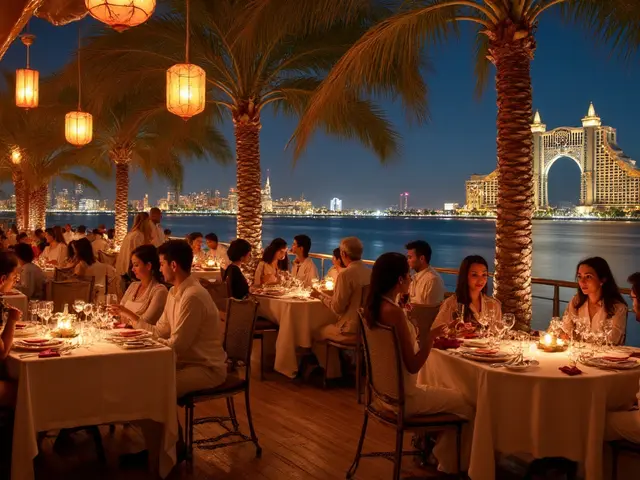Dubai’s skyline isn’t just packed with tall buildings. It’s got stories, bragging rights, and a way of turning ordinary city life into something wild—think dancing fountains under the Burj Khalifa or heading to brunch with views from Address Sky View’s rooftop glass walk. Just walking through Downtown Dubai feels like stepping right onto a postcard.
If you live here, you’ll know how quickly new towers pop up and steal the spotlight. But some landmarks really last, and they give Dubai its global reputation for jaw-dropping design. For anyone who cares about unique buildings or wants epic photos for Instagram, there’s a lot more here than the usual tourist snapshot spots. You’re not just looking at pretty shapes—you’re seeing inside Dubai’s hustle, creativity, and that urge to make everything bigger and better.
Before you gear up for a full architecture tour, check if a building has public access or if you need to book ahead—especially places like Museum of the Future, which tends to sell out on weekends or public holidays. Dress smart, especially when visiting any place near religious sites, and always double-check opening hours during Ramadan or UAE National Day events. Bringing someone who understands Dubai’s building history? That’s bonus points. You’ll notice locals love to show guests around “their” buildings, whether it’s the original Dubai World Trade Centre (ask any old-school business expat) or the modern twisting Cayan Tower at Dubai Marina.
- Record-Breakers and Skyline Superstars
- Cultural Icons: Old Meets New
- Futuristic Shapes and Eco Marvels
- Hidden Architectural Gems Locals Love
- Tips for Exploring Dubai’s Iconic Buildings
Record-Breakers and Skyline Superstars
Almost everyone in Dubai has a story that starts with “Did you know this is the tallest/the biggest/the first of its kind?” and that’s pretty much because of buildings like the Burj Khalifa, Burj Al Arab, and Cayan Tower. These aren’t just fancy views for your phone wallpaper. They’re setting actual world records and bringing in travelers looking for more than sand and sun.
The most obvious superstar? Burj Khalifa. At 828 meters, it’s the tallest building on Earth—and you feel it when you see those shadows stretch at sunset. Want stats? Here’s a quick table that sums up the record-breakers:
| Building | Record/Claim to Fame | Can You Visit? |
|---|---|---|
| Burj Khalifa | Tallest building globally; highest outdoor observation deck (Level 148) | Yes (observation decks, lounges) |
| Burj Al Arab Jumeirah | Self-declared 7-star hotel; iconic sail shape | Yes (hotel guests, pre-booked dining) |
| Cayan Tower | Known for 90° twist design; tallest twisted tower when opened | Residential with occasional events |
| Marina 101 | Tallest residential building in Dubai | Limited public access |
Visiting the Dubai architecture icons? Here’s what helps:
- Book Burj Khalifa tickets online to skip massive lines (tip: sunrise or late evening slots are less crowded).
- Burj Al Arab tours are pricey but cover areas you’d never see as a regular visitor—book high tea at Skyview Bar for the photo ops.
- Cayan Tower’s twist is best seen from the Marina Walk, especially just before sunset when the light bounces off the glass.
- Bring a wide-angle camera lens—these buildings are so tall you’ll need it for a proper shot.
These superstars shape Dubai’s identity, and honestly, there’s nothing like catching the Burj Khalifa light show after dinner at Dubai Mall. If you want to really experience architecture that’s become a drawcard for the whole world, these buildings are your starting point.
Cultural Icons: Old Meets New
This city knows how to mix tradition and cutting-edge design. Right in the Al Fahidi Historical Neighbourhood, you’ll find the Dubai Museum sitting inside Al Fahidi Fort, the oldest standing building in Dubai. Built in 1787, the fort is worlds apart from all the flashy towers. Its thick coral walls were made for real defense, and you can actually touch history here. Tourists and residents still flock to the museum to check out life in old Dubai, from barasti huts to pearl diving gear.
Then, hop over to the Dubai Frame. This one’s pure genius—it literally frames the views between old and new Dubai. Walk on the glass bridge at the top and you’ll see the heritage districts to the north and all the new skyscrapers to the south, all in one shot. Dubai architecture fans love the interactive gallery at the base: it uses augmented reality to show how the city transformed, and the ticket price (around AED 50 for adults, AED 20 for kids) is actually affordable for families.
Jumeirah Mosque is another standout. Opened in 1979, its creamy stone domes get photographed almost as much as the Burj Khalifa. What makes it special: it’s one of the few mosques in the UAE open to non-Muslims for guided tours. The ‘Open Doors. Open Minds.’ program from Sheikh Mohammed Centre for Cultural Understanding runs these tours, letting you ask questions and learn about Emirati traditions—perfect if you’re new in town or have visitors.
Here’s a quick look at key details for these icons:
| Building | First Opened | Main Feature | Public Access |
|---|---|---|---|
| Al Fahidi Fort/Dubai Museum | 1787 | Oldest building; historical artifacts | Museum ticket needed |
| Dubai Frame | 2018 | Glass bridge with city views | Entry ticket (AED 50/adult) |
| Jumeirah Mosque | 1979 | Guided tours for non-Muslims | Tour ticket (AED 35) |
For the best experience, try looping all three in one morning—start at Al Fahidi just after opening, head to Jumeirah Mosque for the 10am tour (don’t forget modest clothes), and finish with the Dubai Frame before the afternoon crowds. This way you really get that journey from Dubai's past to its most creative side.
Futuristic Shapes and Eco Marvels
If you're into the visual side of Dubai architecture, the city pretty much turns every drive into a sci-fi movie set. The Dubai architecture crowd constantly pushes weird, wild, and practical designs. These aren't just buildings—they experiment with green tech and surprising shapes that really set the city apart.
First, you have the Museum of the Future. It’s basically an oval ring covered in Arabic calligraphy, and it glows at night. No corners—just curves. This one is all about Dubai’s obsession with staying ahead of the game. The building’s metal skin not only looks cool but also helps keep it shaded inside, cutting down on AC bills. You have to buy tickets in advance (AED 149 for adults, half-price for kids). Inside, everything is touchscreen or digital, and whole families go just for the slick robotics and VR rooms.
Check out The Opus by Zaha Hadid in Business Bay. Locals know it as the “melting ice cube.” It’s two towers joined at the top and bottom with a big hole in the center. If you're into design, you’ll want pictures near the lobby—it's one of the few buildings in Dubai by a female starchitect. There’s also ME Dubai hotel and some zany lighting installations. You don’t need to stay the night to have a look around the public spaces.
Sustainability gets a real push with the Dubai Frame in Zabeel Park. Everyone snaps photos here, but few people know it actually collects rainwater and uses energy-saving glass. Take the elevator to the top, and you’ll spot old and new Dubai, plus get all the stats about how the Frame saves on resources.
Dubai’s Sustainable City shows what modern eco-living looks like in the desert. This isn’t a tourist hub, but if you’re an architecture nerd, you’ll love a tour or renting a bike to look at the solar-powered homes and greenhouses. The whole neighborhood was built to cut energy bills and encourage recycling. Weekly markets sometimes run tours—ask a local expat group or check the City’s Instagram page for events.
| Building | Unique Feature | Eco Innovation |
|---|---|---|
| Museum of the Future | Oval ring, Arabic calligraphy | Shading metal skin, low-energy systems |
| The Opus | Joined towers, central void | Energy-efficient design, smart glass |
| Dubai Frame | Massive picture frame shape | Rainwater collection, insulated glass |
| Sustainable City | Suburban eco-hub | Solar roofs, water recycling, EV chargers |
If you’re planning to visit, aim for early morning (before noon) or at sunset—not just for the cooler weather but for the way the light hits all those glass and metal surfaces. Sometimes, you’ll catch Instagrammers fighting for the best shot, especially on weekends!
Hidden Architectural Gems Locals Love
Everyone in Dubai knows about the Burj Khalifa and Burj Al Arab. But if you want to get to know the city properly, you have to dig a little deeper. Here are a few spots that locals rave about—places with real personality and fewer crowds. Notice how these buildings are as much a part of Dubai architecture as the big headline-makers.
- Jameel Arts Centre: Sitting right at Dubai Creek, this one’s a different vibe—crisp white cubes, chill sculpture gardens, and regular free exhibitions. It’s not just a gallery, but also a quiet hangout with creek views. You can grab a coffee from the in-house cafe and sit by the water for a while (no pressure to buy anything).
- Etihad Museum: This sleek round structure near Jumeirah is where the UAE’s founding story comes alive. The building is shaped like a manuscript, with seven leaning columns outside (for the seven Emirates). It’s eye-catching and has interactive displays in both Arabic and English.
- Bastakiya Quarter (Al Fahidi Historical District): If futuristic towers get tiring, wander here. It’s a rare physical link to old-school Dubai: maze-like lanes, wind towers, and restored beige houses. Catch the Dubai Culture tour on weekends for extra background—plus, you might stumble on a pop-up art show or Emirati coffee tasting.
- Dubai Opera: Sure, it’s central, but many people just walk past it. The dhow-shaped body isn’t just for looks; it’s a nod to Dubai’s trading and seafaring history. Grab a ticket to any show, and you’ll get a full tour of its design—including how the seating transforms for concerts or theatre productions.
- The Green Planet: Okay, an indoor rainforest isn’t exactly old Dubai, but the glass bio-dome in City Walk is both clever and bold. It houses over 3,000 plants and animals, and the spiral structure lets you see all four rainforest layers up close.
Some of these spots have entry fees, but they rarely go above 50 AED per person—and there are often discounts for kids, families, or UAE residents. Check the list below for a quick look at timings and travel tips:
| Location | Area | Typical Entry Fee | Tip/Quick Fact |
|---|---|---|---|
| Jameel Arts Centre | Jaddaf Waterfront | Free | Closed Mondays |
| Etihad Museum | Jumeirah 1 | 25 AED (adult) | Open daily until 8pm |
| Bastakiya Quarter | Bur Dubai | Free | Best in early morning or late afternoon |
| Dubai Opera | Downtown Dubai | Varies by event | Guided tours available |
| The Green Planet | City Walk | 160 AED (adult) | Peak time: weekends after 2pm |
Pro tip: If you’re touring a few places in one day, use taxis for easy drops—many are less than 20 minutes apart, traffic permitting. And don’t forget, wearing light clothing is key, especially when walking through the Bastakiya alleys. You’ll feel the cultural mash-up that makes Dubai more than just its record-breaking skyscrapers.
Tips for Exploring Dubai’s Iconic Buildings
Checking out Dubai’s famous buildings is way more fun if you go in with a few smart tricks up your sleeve. Here’s how to see the city like someone who actually lives here:
- Dubai architecture tours can be a game changer. You’ll find walks in Downtown, Dubai Marina, or even Old Dubai that offer real background, not just photo ops. Companies like Architectural Heritage Tours and Rove Hotel’s ‘Art Walks’ make it easy for families, friends, or solo explorers.
- Book your tickets early for big-name places. The Burj Khalifa sells out at sunset—especially for levels 124 and 148. The same goes for Museum of the Future on weekends. You’ll save time and skip lines. Watch for special UAE resident rates on their official websites.
- Friday mornings are surprisingly chill at most sights until noon. Dubai gets going a bit later on weekends, so you’ll beat the crowds. For Ramadan, expect shorter opening hours—always double-check before setting out.
- Dress code matters. For malls, towers, and indoor attractions, casual is fine, but cover shoulders and knees if you’ll visit mosques or older heritage spots like Al Fahidi. Bring a scarf or pashmina in your bag just in case.
- Want perfect skyline photos? Head to The Dubai Frame at sunset or try the public beaches behind Jumeirah Mosque for a less crowded angle. Some rooftops like Cé La Vi (at Address Sky View) let you snap iconic scenes for the price of a coffee.
- Watch for special events like Dubai Summer Surprises or art festivals—these often come with pop-up exhibitions in places like ICD Brookfield Place or The Opus by Zaha Hadid. Locals know these dates make even the most popular buildings feel extra lively.
- Parking’s a pain at some landmarks. Rely on the Metro for Burj Khalifa (get off at Dubai Mall/Burj Khalifa Station), Museum of the Future (Emirates Towers Station), and even Deira’s Clock Tower. RTA’s Nol Card is your friend.
Keep in mind, Dubai’s always adding new projects. The next time you head down Sheikh Zayed Road, there’ll probably be a new stunner on the horizon. If you enjoy the journey, not just the buildings, you’ll get the best stories and the best views.



